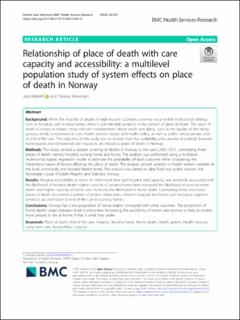| dc.contributor.author | Kalseth, Jorid | |
| dc.contributor.author | Halvorsen, Thomas | |
| dc.date.accessioned | 2023-03-28T12:04:44Z | |
| dc.date.available | 2023-03-28T12:04:44Z | |
| dc.date.created | 2020-12-16T09:45:34Z | |
| dc.date.issued | 2020 | |
| dc.identifier.citation | BMC Health Services Research. 2020, 20, 454. | en_US |
| dc.identifier.issn | 1472-6963 | |
| dc.identifier.uri | https://hdl.handle.net/11250/3060717 | |
| dc.description.abstract | Background: While the majority of deaths in high-income countries currently occur within institutional settings such as hospitals and nursing homes, there is considerable variation in the pattern of place of death. The place of death is known to impact many relevant considerations about death and dying, such as the quality of the dying process, family involvement in care, health services design and health policy, as well as public versus private costs of end-of-life care. The objective of this study was to analyse how the availability and capacity of publicly financed home-based and institutional care resources are related to place of death in Norway.
Methods: This study utilized a dataset covering all deaths in Norway in the years 2003–2011, contrasting three places of death, namely hospital, nursing home and home. The analysis was performed using a multilevel multinomial logistic regression model to estimate the probability of each outcome while considering the hierarchical nature of factors affecting the place of death. The analysis utilized variation in health system variables at the local community and hospital district levels. The analysis was based on data from two public sources: the Norwegian Cause of Death Registry and Statistics Norway.
Results: Hospital accessibility, in terms of short travel time and hospital bed capacity, was positively associated with the likelihood of hospital death. Higher capacity of nursing home beds increased the likelihood of nursing home death, and higher capacity of home care increased the likelihood of home death. Contrasting three alternative places of death uncovered a pattern of service interactions, wherein hospital and home care resources together served as an alternative to end-of-life care in nursing homes.
Conclusions: Norway has a low proportion of home deaths compared with other countries. The proportion of home deaths varies between local communities. Increasing the availability of home care services is likely to enable more people to die at home, if that is what they prefer. | en_US |
| dc.language.iso | eng | en_US |
| dc.publisher | BMC | en_US |
| dc.rights | Navngivelse 4.0 Internasjonal | * |
| dc.rights.uri | http://creativecommons.org/licenses/by/4.0/deed.no | * |
| dc.title | Relationship of place of death with care capacity and accessibility: a multilevel population study of system effects on place of death in Norway | en_US |
| dc.type | Peer reviewed | en_US |
| dc.type | Journal article | en_US |
| dc.description.version | publishedVersion | en_US |
| dc.rights.holder | © The Author(s) 2020 | en_US |
| dc.source.volume | 20 | en_US |
| dc.source.journal | BMC Health Services Research | en_US |
| dc.identifier.doi | 10.1186/s12913-020-05283-6 | |
| dc.identifier.cristin | 1860354 | |
| dc.relation.project | Norges forskningsråd: 214298 | en_US |
| dc.source.articlenumber | 454 | en_US |
| cristin.ispublished | true | |
| cristin.fulltext | original | |
| cristin.qualitycode | 2 | |

